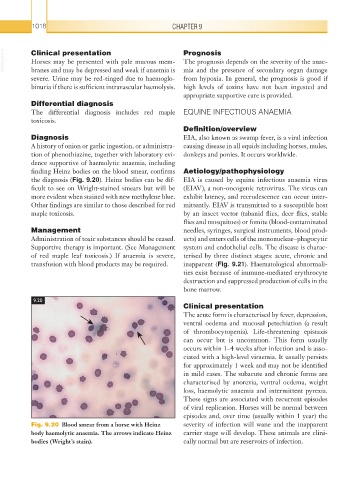Page 1043 - Equine Clinical Medicine, Surgery and Reproduction, 2nd Edition
P. 1043
1018 CHAPTER 9
VetBooks.ir Clinical presentation Prognosis
The prognosis depends on the severity of the anae-
Horses may be presented with pale mucous mem-
branes and may be depressed and weak if anaemia is
severe. Urine may be red-tinged due to haemoglo- mia and the presence of secondary organ damage
from hypoxia. In general, the prognosis is good if
binuria if there is sufficient intravascular haemolysis. high levels of toxins have not been ingested and
appropriate supportive care is provided.
Differential diagnosis
The differential diagnosis includes red maple EQUINE INFECTIOUS ANAEMIA
toxicosis.
Definition/overview
Diagnosis EIA, also known as swamp fever, is a viral infection
A history of onion or garlic ingestion, or administra- causing disease in all equids including horses, mules,
tion of phenothiazine, together with laboratory evi- donkeys and ponies. It occurs worldwide.
dence supportive of haemolytic anaemia, including
finding Heinz bodies on the blood smear, confirms Aetiology/pathophysiology
the diagnosis (Fig. 9.20). Heinz bodies can be dif- EIA is caused by equine infectious anaemia virus
ficult to see on Wright-stained smears but will be (EIAV), a non-oncogenic retrovirus. The virus can
more evident when stained with new methylene blue. exhibit latency, and recrudescence can occur inter-
Other findings are similar to those described for red mittently. EIAV is transmitted to a susceptible host
maple toxicosis. by an insect vector (tabanid flies, deer flies, stable
flies and mosquitoes) or fomite (blood-contaminated
Management needles, syringes, surgical instruments, blood prod-
Administration of toxic substances should be ceased. ucts) and enters cells of the mononuclear–phagocytic
Supportive therapy is important. (See Management system and endothelial cells. The disease is charac-
of red maple leaf toxicosis.) If anaemia is severe, terised by three distinct stages: acute, chronic and
transfusion with blood products may be required. inapparent (Fig. 9.21). Haematological abnormali-
ties exist because of immune-mediated erythrocyte
destruction and suppressed production of cells in the
bone marrow.
9.20
Clinical presentation
The acute form is characterised by fever, depression,
ventral oedema and mucosal petechiation (a result
of thrombocytopenia). Life-threatening epistaxis
can occur but is uncommon. This form usually
occurs within 1–4 weeks after infection and is asso-
ciated with a high-level viraemia. It usually persists
for approximately 1 week and may not be identified
in mild cases. The subacute and chronic forms are
characterised by anorexia, ventral oedema, weight
loss, haemolytic anaemia and intermittent pyrexia.
These signs are associated with recurrent episodes
of viral replication. Horses will be normal between
episodes and, over time (usually within 1 year) the
Fig. 9.20 Blood smear from a horse with Heinz severity of infection will wane and the inapparent
body haemolytic anaemia. The arrows indicate Heinz carrier stage will develop. These animals are clini-
bodies (Wright’s stain). cally normal but are reservoirs of infection.

